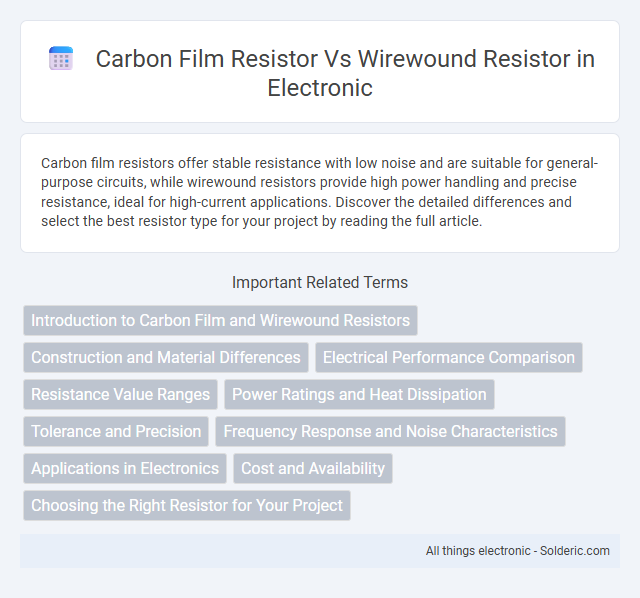Carbon film resistors offer stable resistance with low noise and are suitable for general-purpose circuits, while wirewound resistors provide high power handling and precise resistance, ideal for high-current applications. Discover the detailed differences and select the best resistor type for your project by reading the full article.
Comparison Table
| Feature | Carbon Film Resistor | Wirewound Resistor |
|---|---|---|
| Construction | Carbon film coating on ceramic rod | Wire (usually nichrome) wound around a ceramic core |
| Resistance Range | 1 O to 10 MO | 0.1 O to 100 kO |
| Power Rating | 0.125 W to 2 W | 1 W to 100 W or higher |
| Tolerance | +-5% to +-10% | +-1% to +-5% |
| Temperature Coefficient | Higher (typically +-200 to +-400 ppm/degC) | Lower (+-5 to +-50 ppm/degC) |
| Inductance | Negligible | Higher inductance due to coil structure |
| Noise | Higher noise level | Low noise |
| Applications | General purpose, audio circuits | High power, precision, and audio amplifier circuits |
| Cost | Lower cost | Higher cost |
Introduction to Carbon Film and Wirewound Resistors
Carbon film resistors feature a thin carbon layer deposited on an insulating substrate, offering stable resistance with low noise and cost-effectiveness for general-purpose electronic circuits. Wirewound resistors consist of a metal wire, typically nichrome, wound around a ceramic or fiberglass core, providing high precision, power handling, and thermal stability in demanding applications. The choice between carbon film and wirewound resistors depends on factors such as power rating, tolerance, frequency response, and environmental conditions.
Construction and Material Differences
Carbon film resistors are constructed by depositing a thin carbon film onto an insulating ceramic substrate, offering stable resistance with low inductance. Wirewound resistors consist of a metal wire, typically nichrome or similar alloys, tightly wound around a ceramic or fiberglass core, providing high power handling and precision. The carbon film's layered resistive material contrasts with the wirewound's spiral wire design, affecting performance characteristics such as tolerance, inductance, and thermal stability.
Electrical Performance Comparison
Carbon film resistors offer stable resistance and low noise suitable for general-purpose applications, but their tolerance and temperature coefficient are higher compared to wirewound resistors. Wirewound resistors provide superior precision, low temperature coefficient, and high power handling, making them ideal for high-accuracy and high-power circuits. Your choice depends on the required electrical performance, with wirewound resistors excelling in reliability under heavy load and temperature variations.
Resistance Value Ranges
Carbon film resistors typically offer resistance values ranging from 1 ohm to 10 megaohms, making them suitable for a wide array of general-purpose electronic applications. Wirewound resistors provide precise and stable resistance values, usually between 0.1 ohm and 20 kiloohms, ideal for high-power and high-accuracy requirements. Choosing between these depends on your specific resistance value needs and the application's power handling constraints.
Power Ratings and Heat Dissipation
Carbon film resistors typically have lower power ratings, usually up to 2 watts, and dissipate heat less efficiently due to their thin-film construction. Wirewound resistors offer higher power ratings, often ranging from 5 watts to several hundred watts, and excel in heat dissipation thanks to their metal wire coil design and larger surface area. The superior thermal conductivity and robust structure of wirewound resistors make them ideal for high-power applications requiring effective heat management.
Tolerance and Precision
Carbon film resistors typically offer tolerances around +-5% to +-1%, providing moderate precision suitable for general applications, whereas wirewound resistors boast tighter tolerances often as low as +-0.1%, ideal for high-precision circuits. The lower tolerance of wirewound resistors ensures better stability and accuracy under varying environmental conditions, making them preferable when precise resistance values are critical. You should choose a wirewound resistor if your circuit demands high precision and minimal variance in resistance over time.
Frequency Response and Noise Characteristics
Carbon film resistors exhibit superior high-frequency response with lower inductance and capacitance compared to wirewound resistors, making them ideal for RF applications. Wirewound resistors generate higher noise due to their inductive elements and can introduce unwanted reactive effects at elevated frequencies. Carbon film resistors maintain lower thermal and excess noise, ensuring cleaner signal integrity in sensitive electronic circuits.
Applications in Electronics
Carbon film resistors are widely used in consumer electronics due to their stability, low noise, and cost-effectiveness, making them ideal for general-purpose applications like audio equipment and signal processing circuits. Wirewound resistors excel in high-power and high-precision applications, such as power supplies, motor controls, and industrial equipment, thanks to their superior accuracy and ability to handle higher power dissipation. The choice between carbon film and wirewound resistors depends on factors like power rating, tolerance, and the specific electronic circuit requirements.
Cost and Availability
Carbon film resistors are generally more cost-effective and widely available due to their simple manufacturing process and extensive use in consumer electronics. Wirewound resistors tend to be more expensive because of their precision construction and are primarily available from specialized suppliers targeting industrial and high-power applications. The broad market presence of carbon film resistors makes them a preferred choice for budget-conscious and mass-production projects.
Choosing the Right Resistor for Your Project
Carbon film resistors offer stable resistance with low noise, making them ideal for general-purpose electronic circuits requiring precision and affordability. Wirewound resistors handle higher power dissipation and provide superior accuracy and thermal stability, suitable for high-power applications such as motor controls and power supplies. Selecting the right resistor depends on power rating, tolerance, frequency response, and environmental conditions specific to your project requirements.
Carbon film resistor vs wirewound resistor Infographic

 solderic.com
solderic.com